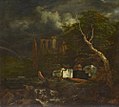The Jewish Cemetery
| The Jewish Cemetery | |
|---|---|
 | |
| Artist | Jacob van Ruisdael |
| Year | 1650s |
| Dimensions | 142.2 cm × 189.2 cm (56.0 in × 74.5 in) |
| Location | Detroit Institute of Arts, Detroit |
The Jewish Cemetery (c. 1650s) is an oil on canvas painting by the Dutch landscape painter Jacob van Ruisdael. It is an example of Dutch Golden Age painting and is now in the collection of the Detroit Institute of Arts.
This painting was documented by John Smith in 1835, who wrote: "60. The Cemetery. This grand and affecting picture exhibits the ruins of a church and convent upon the summit of a hill, occupying the whole extent of the view in the second distance, the declivity of which presents a cemetery, interspersed with large stones. On the foreground are a broken tree lying across a rapid stream, a tomb of black marble, with an inscription on it; a row of three sarcophagi extending along the front; and on the left stands a cluster of large umbrageous trees, the verdant hues of whose foliage is contrasted by the leafless trunk of a beech. Three persons in black are seen near a small tomb on the side of the hill, musing amidst the tombs. The grandeur and solemnity of the scene is strikingly enhanced by rolling stormy clouds, in which may be perceived the evanescent colours of a rainbow. 4 ft. 6 in. by 5 ft. 9 in.—C.
In this excellent picture, the artist has evidently intended to convey a moral lesson of human life; and in addition to this, there is a sublimity of sentiment and effect reigning throughout the composition which renders it worthy of the powers of Nicolo Poussin. The architecture Van Ruisdael depicts symbolize equal partners and drama as both the Portuguese-Jewish burial and the Christian Medieval church are in ruins together along with a dark-skied/rainbow setting.[1]
- Collection of M. Marin, . Paris, 1790. . 2000 fs. 80l.
- Anonymous, . . . . . . . . . . . . . 1802. . :3203 fs. 128l.
The Writer has been informed that this picture was purchased by Mr. Huybens (by whom it was imported into England), of a banker at Paris, about the year 1815, for the sum of 20,000 fs., 800l., and sold to Mr. George Gillows, of whose executors it was brought by Mr. Zachary, and was subsequently sold, in the sale of that gentleman's collection, by Mr. Phillips, in 1828, for 870 gs.; it is now in the possession of Mackintosh, Esq.
A duplicate of the preceding picture, but differing in size, and inferior in quality, having become dark from time, is in the Dresden Gallery. 3 ft. by 3 ft. 5 in.—C."[2]
This scene is very similar to other paintings of ruins Ruisdael made in this period and these often served as inspiration for later painters of landscape.

The painting referred to as a duplicate above (considered genuine by later experts) Gemäldegalerie Alte Meister.
Later historians have traced earlier drawings by Ruisdael and concluded that the scene is actually a pastiche of two locations; a view of the Jewish cemetery 'Beth Haim' in Ouderkerk aan de Amstel with the ruins of Egmond Abbey (St. Adalbert's Abbey) in Egmond-Binnen.
See also[]
References[]
| Wikimedia Commons has media related to The Jewish Cemetery by Jacob Isaacksz. van Ruisdael. |
- ^ Scheyer, Ernst (1977). "The Iconography of Jacob van Ruisdael's Cemetery". Bulletin of the Detroit Institute of Arts. 55 (3): 145. doi:10.1086/DIA41504600. JSTOR 41504600. S2CID 192799456 – via JSTOR.
- ^ Entry 60 for ''The Cemetery in Smith's catalogue raisonné volume 6, 1835
- 1650s paintings
- Paintings by Jacob van Ruisdael
- Paintings in the collection of the Detroit Institute of Arts
- Jews and Judaism in art


